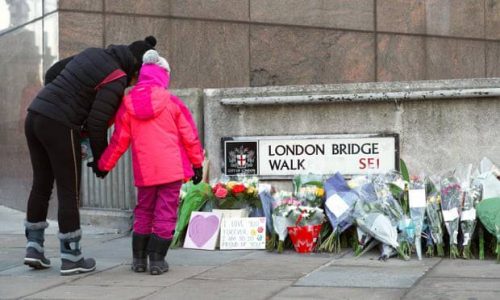
Islamic extremism remains dominant UK terror threat
The attack on London Bridge shows the Islamist threat remains strong in the UK, counter-terrorism and counter-extremism experts have said, warning against complacency.
The murder of Jack Merritt and Saskia Jones on 29 November by Usman Khan was the first fatal Islamist terror incident in two years.
The conversation around extremism and counter-terrorism has been focused on the threat from the far right in the last year following attacks including the Christchurch mosque shootings in New Zealand, the El Paso Walmart shooting in the US and the synagogue killings in Halle, Germany.
But while UK authorities have warned the far right is the fastest growing threat, Islamist extremism remains the dominant form.
On Monday night, a man was arrested in the Bristol suburb of Clifton on suspicion of Islamist-related terrorism offences. The 33-year-old was held on suspicion of the commission, preparation or instigation of acts of terrorism, Avon and Somerset police said. They added it was not linked to the London Bridge attack.
Charlie Winter, senior research fellow at the International Centre for the Study of Radicalisation and Political Violence, at King’s College London, said: “As far as I’m concerned, the threat didn’t go away – if anything, having been defeated in Baghouz [in Syria] earlier this year, the Islamic State’s appetite for terror attacks in the UK is greater now than it’s ever been.
“That said, there’s a gulf between appetite and capability, and, besides seemingly isolated incidents like [London Bridge], whether or not the group is able to sustainably and effectively push would-be attackers over the edge remains to be seen.”
Milo Comerford, Islamist extremism lead at the Institute for Strategic Dialogue (ISD), an organisation countering extremism across the ideological spectrum, said: “The London Bridge attack shows we’re not over the hill with Islamist extremism and points to a new phase of the challenge we’re facing.
“There is a growing far-right threat and that needs to be seen in context. That, and the defeat of Isis, shouldn’t mean we should take our eye off the ball on Islamist extremism.”
Isis has been driven out of Iraq and Syria, where they once exerted control over great swathes of the countries. This has removed a geographical stronghold but the ideology remains.
Comerford said: “With the decline of the caliphate in its territorial form, we’re seeing less of the challenges we saw in 2014-15 around foreign fighters and the migration challenge.
“Now, we’ve been talking for a long time about the fact we need to be preparing for when they come back, what happens when these people are locked up on terrorism charges, what happens when they come out of prison. This shows we really need to build up this infrastructure and this architecture that doesn’t exist in the form it needs to at the moment.”
Khan was jailed in 2012 for his role in an al-Qaida-inspired plot to recruit and train jihadis at a madrassa in Pakistan. Despite taking part in some deradicalisation courses in prison, he launched the London Bridge attack a year after his release.
“The prevention architecture is the key bit and the much more cost-efficient part in some ways,” Comerford said. “It’s always going to be a challenge to deprogramme, deradicalise or disengage individuals.”
While the far right is clearly on the rise – a global terrorism index recently pointed to a 300% increase over the past five years – Comerford said it was still a tiny fraction of the total worldwide threat.
“There is a risk of chasing the latest fad,” Comerford said. “When you take the long view, we’ve been monitoring this for the last 10 years, and looking at how the Islamist challenge has morphed and metastasised. The far-right threat has been hypercharged and the online space has provided a major platform for that, and major challenges for tech companies and police and so on.
“There’s a slight sense that the Islamist threat is wrapped up and a done deal. The Labour manifesto ignores Islamist extremism entirely. It talked about ‘far right and others’ when it talked about how it dealt with terrorism.
“That suggests it’s all wrapped up and defeating the caliphate on the ground was the end of the challenge … but this ideology is very resilient and morphs and takes new forms and it can be group-based but it can be individual-based like in the case of Usman Khan.”
Since 2017, law enforcement agencies in the UK said there have been 25 foiled plots, at least 16 of which were Islamist.
In 2017-18, of the 7,318 individuals referred to the authorities, 3,197 or 44% were referred for concerns related to Islamist extremism and 1,312 or 18% were referred for concerns related to rightwing extremism.
There were 224 people held in custody for terrorism-related offences in the UK in the year to the end of September, the most up-to-date figures show, and the vast majority, 77% or 173, were described as holding Islamist-extremist views.
Raffaello Pantucci, senior associate fellow at the Royal United Services Institute (Rusi), said the absence of fatal attacks in the last two years showed the security services were doing their job, rather than a lessening of the threat.
“The absence of reporting around a terrorist group, or discussion around it, doesn’t mean the threat has gone away, it means the security forces are managing it in a more effective way.
“The hoopla around the far right is in a way because they didn’t have a grip on that threat. You’ve seen escalating number of arrests, escalating number of plot disruptions, because from their perspective when you disrupt a plot when it comes to a mature level, like building a bomb, that’s a late stage in the game.”
Khan was shot dead by firearms officers on London Bridge after fleeing from Fishmongers’ Hall on the north bank of the Thames where he killed Merritt and Jones. An inquest heard they had been stabbed in the chest.
Source: Guardian





